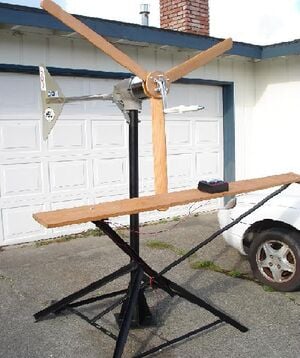
Wind turbines provide a way to produce electricity through a clean renewable resource of moving air. It is clean in that there is no direct pollutant produced in the production of electricity, and renewable in the aspect that the wind will always blow. This project is designed to give a basic understanding to anyone who may be interested in the mechanics involved in converting the energy of wind into electrical energy. This is a basic knowledge that could spark interest in others and initiate further study.
Project Guidelines/Description[edit | edit source]
Having a couple of meetings with CCAT, we were able to get a clear picture of what they wanted to do with the wind turbine that was available for this project. CCAT was not the best location for a fully functional wind turbine due to obstruction of wind flow. Also the turbine for this project has had a rough life and is no longer capable of being an efficient energy producer. Since returning this wind turbine to its former glory was not a very good option, CCAT wanted a demonstrative display that people could interact with and learn how wind turbines generate energy by turning the blades and seeing some sort of results from their input. Consequently, the wind turbine would also need to be sturdy, safe and mobile while still allowing interaction.
Planning and Testing[edit | edit source]
In order to determine what kind of appliances we could run, we had to see what kind of electrical output the wind turbine was capable of producing. We had three wires to test, and after a few attempts we were able to determine that the turbine was producing AC current. By spinning the blade mounts with our hands, we were able to produce peek alternating voltages of +2.5 VDC and -2.5 VDC through two of the wires. This alternating between positive and negative was evidence enough to determine the output was AC. The third wire was determined to be neutral. 2.5V is not much; a little less than two AA batteries in series, but we determined that this would be enough to light a bank of LED's. Also we wanted to put a volt meter somewhere as well so people could see how many volts they could produce. The wind turbine also needed new blades. The old blades were nowhere to be found, so design was up to us. Wood seemed to be a common material used in the construction of blades, as well as being a material that we had the capabilities to work with. This demonstrative model also needed a solid frame. We designed a four sided pyramid shape frame that would give a wide, sturdy base.(pictured below) It also needed to be mobile, so we wanted to put some sort of wheels on, so when the whole unit is tilted back it will roll on the wheels, just like a shop dolly.
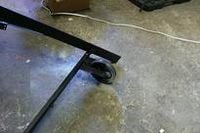
Materials and Tools Used[edit | edit source]
| Materials | Tools |
|---|---|
| 1" x 4" x 16' clear Doug fir | Table saw |
| 1" x 6"x 8' pine | Cross cut saw |
| 2' x 2' x ½" plywood | Hand plains |
| Various strips of sheet metal | Palm sander |
| 6 metric blade mounting bolts | Disk sander |
| Various length 5/16" bolts, nuts and washers | Band saw |
| 12" x 3/4" threaded rod with nuts and washers | Hack saw |
| Recycled plastic mop handle | Various drills |
| Hose clamp | Wrenches |
| 2 old metal bed frames | Cutters |
| 1 can rust stop primer | Pliers |
| 1 can black paint | Hammers |
| 12 oz. outdoor deck stain | Screwdrivers |
| Bicycle crank | Sockets |
| 20' of 10 gauge wire | Low voltage MIG welder |
| 20 ohm resistor | Clamps |
| Variety pack LED's | Levels |
| 16V Capacitor | Multimeter |
| 50V 25amp Bridge Rectifier | Universal Breadboard |
| 15 VDC volt meter | Measuring tape |
| Meter Box | and |
| Various wire nuts and connectors | Our hands |
Construction[edit | edit source]
Blades[edit | edit source]
The blades were constructed of clear (no knots) Douglas fir. We thought it was easier to work with wood than other materials, especially since we had access to the HSU Wood Lab. When planning how to construct the blades, we realized it was going to be more of a removal process. We found a cross sectional picture of a blade that we wanted to emulate.
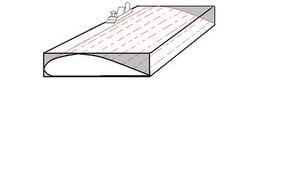
By cutting out and tracing the shape on the end grain of our fir, various hand planes were used to cut the shape through out the length of the board.
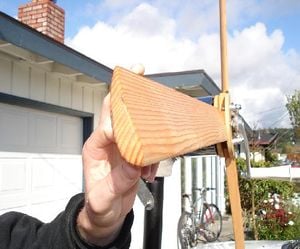
Once the desired shape was obtained, the blades were finish sanded and the tips were rounded off. Now we needed to make two mounting plates with holes matching that of the turbine mounting plate. These plates were made out of free plywood found in the scrap bin at the wood lab. The plywood was cut into circles the same diameter as the turbines diameter. A piece of paper was then placed over the turbine mount and scribbled on, providing an outline of the mount and holes. This outline was then used to transfer the hole pattern on the turbine to the plywood mounts. After the holes were made and proven to be accurate, the mounting portion of the blades were placed between the plywood mounts and arranged in the proper spacing then marked for holes to be drilled. After the blades were drilled the whole blade assembly (blades and two mounts) was bolted on to the turbine blade mount. When the bolts are tightened the ply wood mounts sandwich and tighten on the blades, eliminating any loose fits.
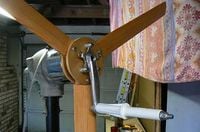
Our hand crank was constructed of an old bicycle crank, a 12" piece of threaded rod, a 10" long piece of 1" steel pipe, and some plastic tubing from an old mop. The threaded rod was fed through the crank were the pedal would normally attach. The pipe was then feed over the threaded rod and the plastic tubing over that. A nut and washer were then placed on each end of the threaded rod, tightening the pipe, crank connection, but still allowing the plastic tubing spin freely on the pipe. This was then bolted to the front plywood blade mount, using the original crank set mounting holes. We had to use a lot of washers with bolts to provide clearance from the bolt heads that hold the blades in place. At this point the blades and mounts were removed and finished with Thompson's deck stain to protect them from water damage that could crack and warp the wood. In hindsight, we could have looked around for an environmentally friendly finish, but we knew this worked well and it was already paid for by our wood lab shop cards.
Frame[edit | edit source]
The frame was built out of two reclaimed bed frames that we found stashed in the back yard. We designed a four sided pyramid shape frame that would offer wide support in all directions. We first clamped the four legs in place on the tower while it sat on level ground and then proceeded to try to tack them in place to get a better visual. Every thing was how we liked it so we removed the clamps and two of the four legs fell to the ground. The tower was galvanized and was not getting any penetration on the welds. Using a disk grinder and ventilator we were able to remove the outer galvanized coating and weld successfully. The four legs by themselves did not offer much support. Using the smaller bed frame as cross bracing, the frame became a lot more ridged. The frame also needed to be mobile, so we designed a dolly like mount using training wheels. This would allow the turbine to be easily moved from place to place by one person.
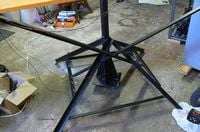
Railing/meter mount[edit | edit source]
The railing has a dual purpose. One, to keep people out of the spinning blades and two to provide a place to mount the volt meter LED box and interpretive materials, such as how wind turbines work, etc. Two more sections of bed frame were welded to the frame in a way that they would protrude upwards towards the user interface. A 1" x 4" x 6' piece of pine was then mounted across the tops of the protruding pieces to form the railing and meter mount.
Building LED and meter box[edit | edit source]
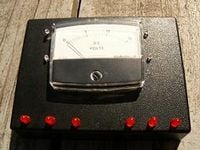
.
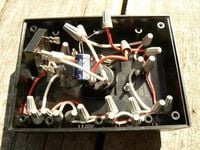
We new that we would not have much more that 2.5 volts to work with, so we used a breadboard and two AA batteries in series to run tests. This produced a 3.00 VDC circuit which made a good simulation of the DC output we desired. We then started placing LED's in parallel with the 3.00 VDC. We were able to place about 15 LED's in parallel before the LED's would not light. We decided to use 10 since we did not know if we would get 3.00 V, and we wanted the lights to be bright. Also, a 20 ohm resistor needed to be placed in series with the LED's so that an unexpected large electrical surge of some sort would not burn out the LED's. First however, we would have to convert our AC current to DC current since LED's only allow the flow of electricity in one direction and therefore require DC current. In order to do this we would have to make or buy a full wave rectifier. AC current pulses back and forth but we only want it going in one direction. A rectifier uses diodes, which only allow electricity to flow in one direction. By arranging four of these diodes correctly in a circuit, a rectifier is made. This rectifier redirects the back and forth pulsing of AC current into a one directional current, DC. However, this does not produce the smoothest current; there are still quick peeks and dips in the current. To over come this, a capacitor may be needed. A capacitor acts as a buffer, much like a battery would. When there is extra power in the circuit, the capacitor stores that extra, but when the power is less in the circuit than in the capacitor, the capacitor releases some of what it has stored. This in effect rounds the peeks and fills the dips, producing a very steady current. We also decided to attach a volt meter so some sort of measurable output could be viewed.
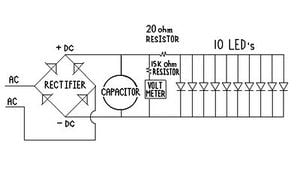
Motive Engineering[1] allowed us to use their wire feed mig welder earlier in the project. They wanted to help by donating some of the materials that they had a lot of. A black plastic wiring box that they use in their solar powered wheel line kits and 20 feet of 10 gauge wire given to us free of charge. The plastic wiring box serves the purpose of containing the Volt Meter and LED's while protecting the wiring connections from the elements. We knew from our previous testing that we wanted to install ten LED's in parallel. We marked the black plastic box at the locations that we wanted to put LED's. We then drilled two holes for each positive and negative side of each LED. Using the ten gauge wire and wire nuts we connected the appropriate positive longer wire of each LED to the positive of the next and the same for the negative ends of the ten LED's to make them in parallel. The Volt Meter was also wired in parallel so that it would measure the voltage across the whole circuit. The Capacitor was also wired in parallel so as to store excess voltage in the way we wanted. The volt meter also had a 15K ohm resistor in series with it in order to obtain accurate voltage readings. A 20 Ohm resistor was also added in series with the bank of LED's to prevent them from getting to much current and burning out. Sizing of this resistor was determined by placing this resistor in series with three AA batteries in series. One LED was also placed in parallel. Three AA batteries in series would be enough to burn out the single LED without a resistor, but with the 20 ohm resistor in series, the LED did not burn out, but still lit up, proving to be sufficient for the job. A much larger hole was made with a hacksaw blade and box cutter so that the meter could also be mounted in the box.
Costs[edit | edit source]
| Quantity | Materials | Source | Cost | Total |
|---|---|---|---|---|
| 1 | 15 VDC Volt Meter | Radio Shack | $13.93 | $13.93 |
| 1 | 25 amp, 50 V Rectifier | Radio Shack | $3.57 | $3.57 |
| various | LED's, Resistors, Capacitors | Redwood Electronics | $26.21 | $26.21 |
| various | Nuts, Bolts, Washers and Hose Clamp | Hensel's Ace Hardware | $14.06 | $14.06 |
| 1 | 1"x4"x16' clear dug fir | Arcata Lumber | $11.79 | $11.79 |
| multiple | other parts | Donated or found scrap | 0 | 0 |
| Total Cost | $69.52 | |||
Conclusions[edit | edit source]
This has been an interesting project that has taught us a lot through the process of designing and building a wind turbine display. We not only learned a lot about wind energy, but also electricity in general. Hopefully, this will be a helpful tool in the future for helping others to understand the concepts behind wind energy through a first hand experience.
Discussion[edit | edit source]
Things to keep in mind and Warning[edit | edit source]
Taking into consideration that this is a relatively slow moving, interpretive display, we were able to avoid having to deal with a lot of the obstacles that one would have to overcome when dealing with a fully functional wind turbine. For example, the blade angles and shape must be very precise in order to be efficient energy producers. Also, just like the tires on a car, the blades must be in perfect balance to maintain an even outward force around the axis of rotation to avoid wobbles. For these reasons we would not suggest trying to build your own blades for a fully functional, high speed turbine unless you are very confident in your wood working skills and ready to do a lot of research. Though this demonstrative model does not spin very fast, it still moves fast enough to hurt someone, especially since people will be interacting with it. Precautions should be taken to insure that the rotating blades are free of sharp edges and clear of all people and spectators.